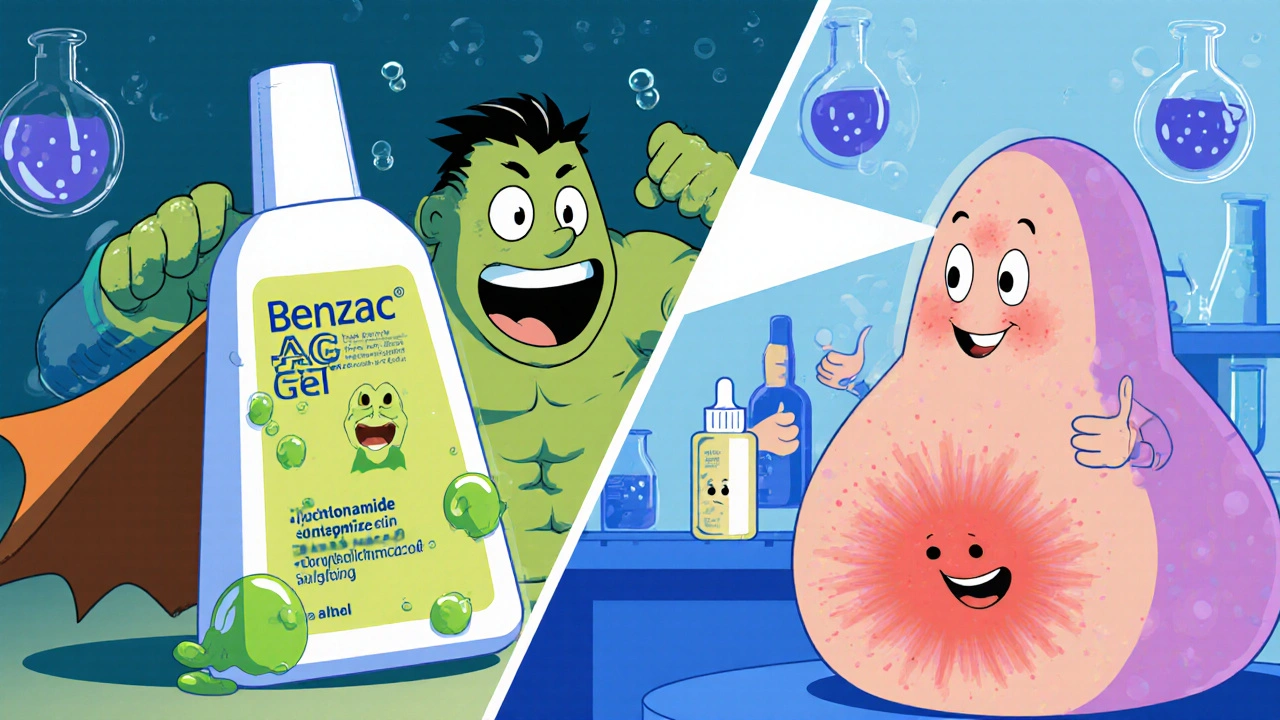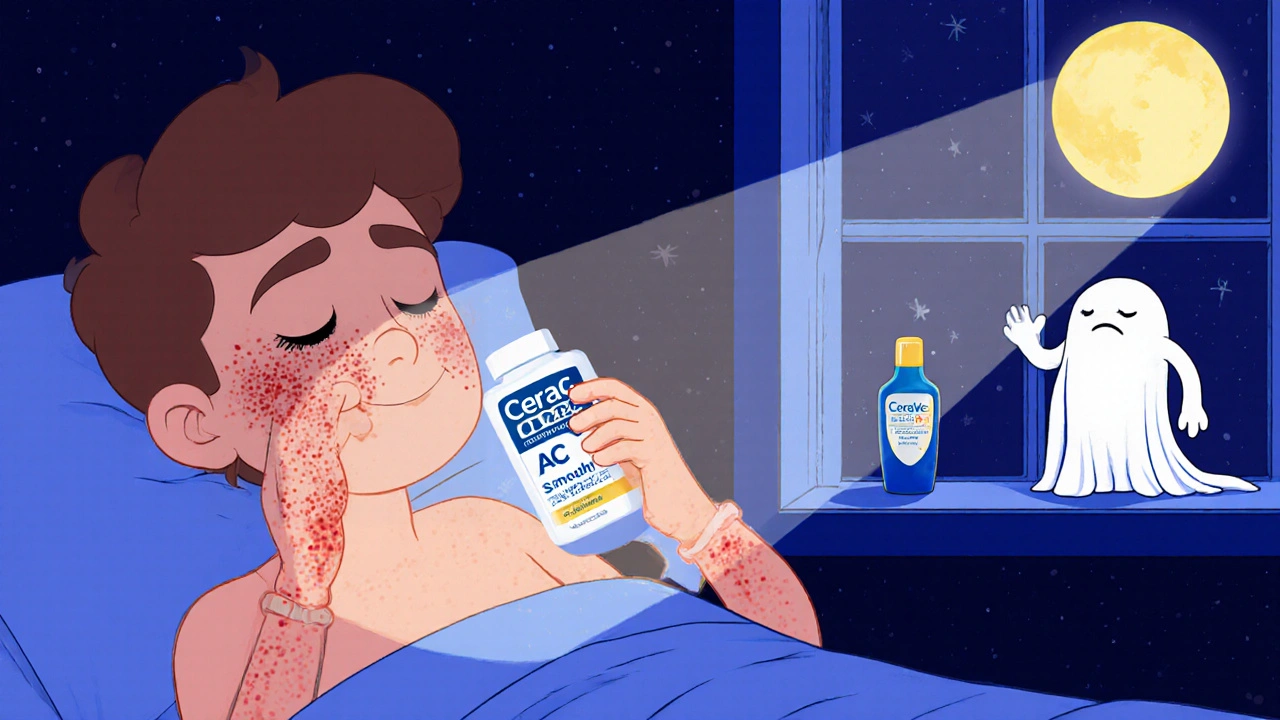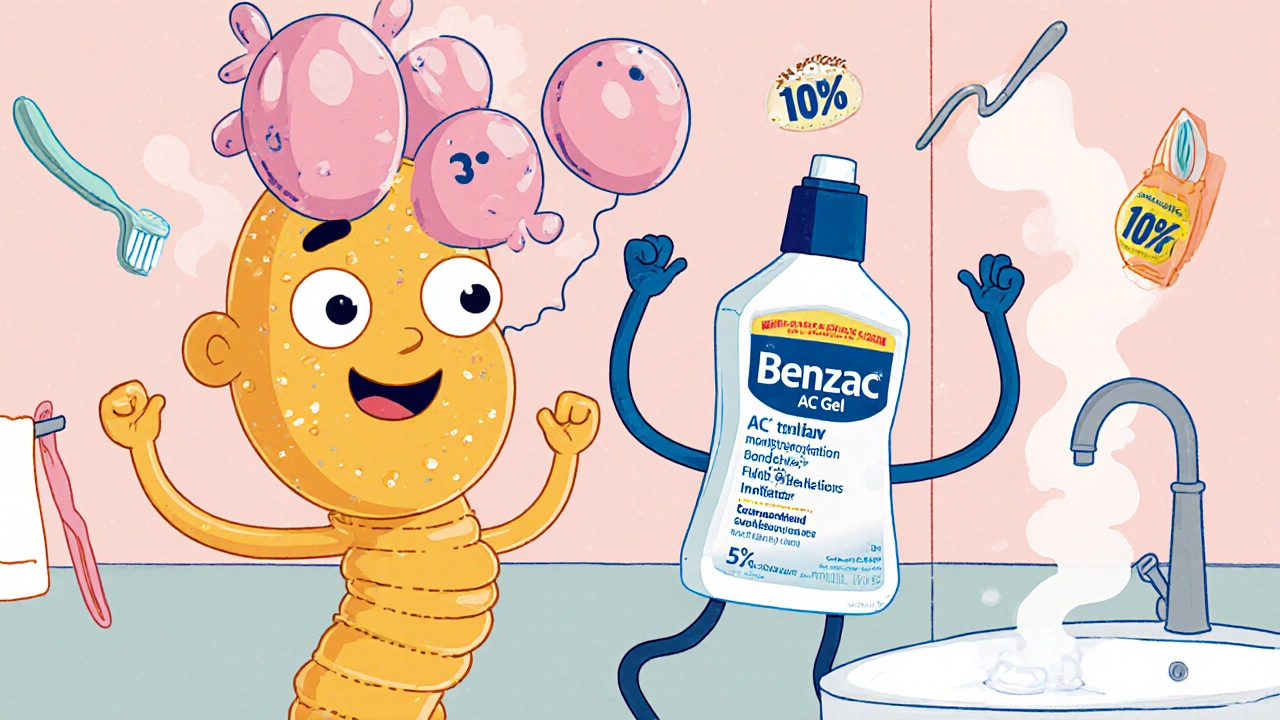Acne Treatment Selector
Find Your Best Acne Treatment
Answer a few questions about your skin type and acne to get personalized recommendations based on clinical evidence.
Your Personalized Acne Treatment Recommendations
Acne doesn’t care if you’re 14 or 40. It shows up when you least expect it - right before a big meeting, a date, or a family photo. If you’ve tried washing your face more often, skipped makeup, or even changed your diet, and still see those red, angry bumps, you’re probably looking at benzoyl peroxide. Benzac AC Gel is one of the most common prescriptions in the UK for acne, but it’s not the only option. So how does it stack up against other treatments? And more importantly, which one actually works for your skin without drying it out or causing more irritation?
What Benzac AC Gel Actually Does
Benzac AC Gel contains 5% or 10% benzoyl peroxide, depending on the version you get. It’s not just another spot treatment - it’s a full-on acne fighter. Benzoyl peroxide kills the bacteria that cause acne, reduces oil production, and helps unclog pores by shedding dead skin cells. It’s been used since the 1950s and still works better than most newer ingredients for inflammatory acne - the kind with pus-filled bumps, not just blackheads.
Most people see results in 4 to 6 weeks. Some notice less redness after just 10 days. But here’s the catch: it can be harsh. If your skin is sensitive, you might get peeling, burning, or even a rash. That’s why many people stop using it - not because it doesn’t work, but because it hurts to use.
How Benzac AC Compares to Other Benzoyl Peroxide Products
Benzac AC isn’t the only benzoyl peroxide gel on the shelf. You’ll find others like Acnecide, Acnecare, and even generic store brands. So what’s the difference?
Most over-the-counter benzoyl peroxide gels have the same active ingredient - but the base matters. Benzac AC uses a water-based formula that’s less greasy than older versions. It’s designed to absorb quickly and not stain clothes. Acnecide, for example, has a thicker gel texture that can feel sticky. Some users say Acnecide stays on longer, which might help with effectiveness, but it also increases the chance of irritation.
Generic versions often cost less, but they might use lower-quality carriers that don’t release the benzoyl peroxide evenly. A 2023 study from the British Journal of Dermatology found that branded formulations like Benzac AC released the active ingredient more consistently over 12 hours compared to generics. That means better results with fewer side effects.
Top Alternatives to Benzac AC Gel
If Benzac AC burns your skin or doesn’t clear your acne after 8 weeks, it’s time to look at alternatives. Here are the most effective ones backed by clinical data.
Adapalene Gel (Differin)
Adapalene is a retinoid - a vitamin A derivative. Unlike benzoyl peroxide, it doesn’t kill bacteria. Instead, it prevents clogged pores from forming in the first place. It’s great for blackheads and whiteheads, and it’s less irritating than benzoyl peroxide. Many people use it at night and benzoyl peroxide in the morning to cover both causes of acne.
Studies show adapalene works as well as benzoyl peroxide for mild to moderate acne, but with fewer reports of redness and peeling. The downside? It takes longer. You might not see results until week 8 or 12. And it can make your skin more sensitive to sunlight, so sunscreen is a must.
Clindamycin Gel (Cleocin T)
This is an antibiotic gel, usually prescribed for people who can’t tolerate benzoyl peroxide. It kills acne-causing bacteria, but it doesn’t unclog pores. That’s why it’s often paired with benzoyl peroxide - the combo reduces the risk of bacteria becoming resistant to antibiotics.
Clindamycin works faster than adapalene, with noticeable improvement in 3 to 4 weeks. But if you use it alone, your acne is likely to come back. It’s also not available over-the-counter in the UK. You’ll need a prescription.
Salicylic Acid Cleansers and Spot Treatments
Salicylic acid is a beta-hydroxy acid that dissolves oil and clears out pores. It’s gentler than benzoyl peroxide and good for oily skin types. You’ll find it in cleansers, toners, and spot treatments. It’s not as strong for inflamed pimples, but it’s excellent for preventing new breakouts.
Many people use salicylic acid in the morning and a gentler moisturizer at night. It’s safe for daily use and doesn’t bleach towels or clothes like benzoyl peroxide does.
Nicotinamide (Vitamin B3) Serums
Nicotinamide is a newer player in acne treatment. It reduces inflammation, controls oil, and even helps fade acne scars. A 2024 trial published in the Journal of Clinical and Aesthetic Dermatology showed that 4% nicotinamide serum was as effective as 1% clindamycin for reducing inflammatory acne after 12 weeks - with zero irritation.
It’s not a quick fix. You need to use it every day for at least 8 weeks. But if you have sensitive skin, rosacea, or just want something that doesn’t burn, this is a solid choice.

What Works Best for Different Skin Types
Not everyone’s skin reacts the same. Here’s a quick guide based on real-world skin types.
- Oily, acne-prone skin: Benzac AC 10% or a combination of benzoyl peroxide and salicylic acid. Works fast, targets bacteria and oil.
- Combination skin: Benzac AC 5% at night, salicylic acid cleanser in the morning. Balances oil without over-drying.
- Sensitive or dry skin: Nicotinamide serum or adapalene gel. Skip benzoyl peroxide unless you start with 2.5% and use it every other day.
- Dark skin tones: Avoid high-strength benzoyl peroxide. It can cause post-inflammatory hyperpigmentation. Stick to adapalene or nicotinamide to reduce redness without dark spots.
- Teenage acne: Benzac AC 5% paired with a gentle moisturizer. Teens often have oily skin and respond well to benzoyl peroxide.
How to Use Benzoyl Peroxide Without Irritating Your Skin
If you’re going to use Benzac AC, here’s how to make it work without turning your face into a red, flaky mess.
- Start with the 5% version. Don’t jump to 10% unless your skin has already tolerated 5% for 4 weeks.
- Apply a pea-sized amount to your entire face, not just spots. Acne forms under the surface before it pops up.
- Use it at night. Benzoyl peroxide breaks down in sunlight and can make your skin more sensitive.
- Wait 15 minutes after washing your face before applying. Wet skin increases absorption - and irritation.
- Moisturise after 20 minutes. Use a fragrance-free, non-comedogenic moisturiser. CeraVe or La Roche-Posay Toleriane are good choices.
- Use sunscreen every morning. Even on cloudy days. Benzoyl peroxide makes you more prone to sunburn.
- Don’t mix with other strong actives like retinol or AHA/BHA until your skin adjusts.

When to See a Dermatologist
Most people can manage acne with over-the-counter or prescription gels. But if you’ve tried two or three treatments for 12 weeks and still have deep, painful cysts, or if your acne is leaving scars, it’s time to see a specialist.
Dermatologists can prescribe oral antibiotics, hormonal treatments (like the combined pill for women), or isotretinoin for severe cases. These aren’t quick fixes - they’re long-term solutions. But for stubborn acne, they work where topical gels fail.
Final Verdict: Benzac AC vs Alternatives
Benzac AC Gel is still one of the most effective acne treatments available. It kills bacteria fast, reduces inflammation, and prevents new breakouts. But it’s not for everyone.
If you have oily skin and no sensitivity issues, Benzac AC 5% is a solid first choice. If your skin reacts badly, switch to adapalene or nicotinamide. For moderate acne, combining benzoyl peroxide with salicylic acid or clindamycin gives better results than using either alone.
The key isn’t finding the strongest product - it’s finding the one your skin can tolerate long enough to work. Acne treatment is a marathon, not a sprint. And sometimes, the gentlest option wins.
Is Benzac AC Gel better than Differin for acne?
It depends on your acne type. Benzac AC (benzoyl peroxide) works best for inflamed, pus-filled pimples by killing bacteria. Differin (adapalene) is better for blackheads and preventing new breakouts by unclogging pores. Many people use both - benzoyl peroxide in the morning and adapalene at night - for full coverage. Benzac AC works faster; Differin works longer-term with less irritation.
Can I use Benzac AC Gel every day?
You can, but most people start with every other night to let their skin adjust. If your skin feels tight, red, or peels, cut back to 2-3 times a week. Once your skin builds tolerance - usually after 4-6 weeks - you can move to daily use. Always follow up with moisturiser and sunscreen.
Does Benzac AC Gel bleach clothes?
Yes, it does. Benzoyl peroxide is a bleaching agent. It can turn towels, pillowcases, and clothing white or discoloured. To avoid this, let the gel dry completely before touching fabric, and use white or old bedding. Some people apply it before bed and wear an old T-shirt to protect their sheets.
How long does it take for Benzac AC to work?
Most people see improvement in 4 to 6 weeks. Some notice less redness after 10 days, but full results take time. If you don’t see any change after 8-12 weeks, the treatment isn’t working for your skin type. Try switching to adapalene or nicotinamide, or consult a dermatologist.
Is it safe to use Benzac AC with other acne products?
Be careful. Don’t combine it with other drying or exfoliating products like retinol, AHA, BHA, or strong scrubs. This can cause severe irritation. If you want to use multiple treatments, space them out - use benzoyl peroxide in the morning and a gentle moisturiser or nicotinamide at night. Always patch test new products.
 Oct, 25 2025
Oct, 25 2025
